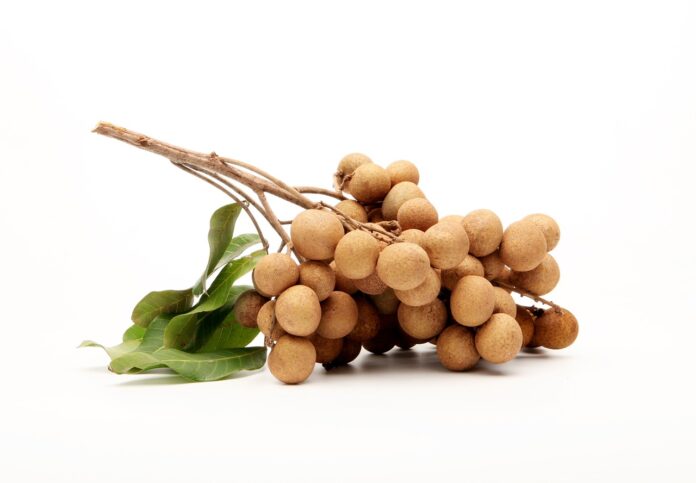Longan, scientifically known as Dimocarpus longan, is a tropical fruit belonging to the soapberry family (Sapindaceae), which also includes lychee and rambutan. The name “longan” translates to “dragon’s eye” in Chinese, owing to the fruit’s resemblance to an eyeball when peeled: the translucent flesh surrounds a single dark seed, resembling a pupil. Native to Southeast Asia, longan trees thrive in warm climates and are particularly common in China, Thailand, Vietnam, and India.
Interesting Facts About Longan:
- Also Called “Dragon’s Eye”: The nickname comes from its unique appearance when peeled. The translucent, jelly-like flesh envelops a large, shiny black seed, creating an effect that resembles the eye of a dragon. This resemblance has cultural significance in East Asia, where dragons are mythical and revered creatures. The seed itself is not edible and has a smooth, glossy texture
- Culinary Uses: Fresh longan is often eaten on its own as a snack, but dried longan is a common ingredient in Chinese herbal soups and teas. It is used to add a natural sweetness and a slightly musky aroma to dishes. In desserts, it is added to fruit salads, jellies, and even ice creams. The dried version is particularly popular for infusing flavor into both sweet and savory dishes
- High in Vitamin C: Longan is an excellent source of vitamin C, providing over 80% of the recommended daily intake in just a small serving. This vitamin is essential for immune function, collagen synthesis, and iron absorption. It also acts as an antioxidant, helping to fight inflammation and keep skin radiant
- Low in Calories: Longan is ideal for those who want a healthy, guilt-free snack. A serving of about 100 grams of longan contains only around 60 calories, making it a great option for weight management. The fruit also has a high water content, helping to keep you hydrated while curbing hunger
- Large-scale Production: Thailand holds a significant record for longan production, being the world’s largest exporter. In 2020, they cultivated over 8 million tons of the fruit. The country invests heavily in off-season techniques using potassium chlorate to ensure year-round harvests and to meet high global demand
- Grows in Tropical Regions: Longan trees are native to tropical regions like southern China, northern Thailand, and Vietnam. They thrive in warm, humid environments and are also cultivated in subtropical areas. The trees can tolerate brief periods of cold, but they generally need plenty of sun and well-drained soil to flourish
- Unique Growing Techniques: Farmers in Thailand and China have developed innovative methods to combat natural challenges like wind and heavy rainfall. One such practice involves supporting heavy branches with bamboo poles and mounding soil around trunks to strengthen the trees against storm damage
- Harvest Season: Depending on the region, longan is harvested between June and August. The trees bloom in the spring, and the fruit is ready for picking by summer. In some areas, multiple harvests may occur, but the peak season generally offers the best flavor and quality
- Grows Well in the USA: In the United States, Florida and Hawaii have favorable conditions for longan cultivation. The trees need temperatures between 70°F and 85°F and are sensitive to frost. Growers in these states have successfully cultivated longan, contributing to its availability in U.S. markets
- Longan Wine: In some regions, longan is used to make wine. This wine has a sweet, rich flavor with floral notes, capturing the essence of the fruit. The fermentation process brings out complex flavors, making longan wine a unique and aromatic beverage enjoyed in many cultures
- Prevents Anemia: Longan contains a modest amount of iron, which helps in producing hemoglobin, the protein that carries oxygen in the blood. Regular consumption of longan can assist in preventing anemia, especially when combined with vitamin C, which enhances iron absorption
- Delicate Flavor: The taste of longan is described as sweet and floral, with a hint of muskiness that sets it apart from lychee. This unique flavor makes it a versatile fruit for both sweet and savory dishes. Some even use longan in sauces and marinades to add a delicate, fruity note
- Great for Desserts: Longan is a common ingredient in Asian desserts like coconut jellies, agar-agar, and fruit salads. It pairs well with tropical flavors like coconut, mango, and passionfruit. In Vietnam and Thailand, longan is often enjoyed with shaved ice or as part of sweet soups
- Slow Tree Growth: Longan trees can take several years to bear fruit, typically between 3 to 7 years, depending on growing conditions. Patience is essential for gardeners, but the reward of harvesting homegrown longan makes the wait worthwhile. The trees produce clusters of fruit that are hand-picked during the harvest season
